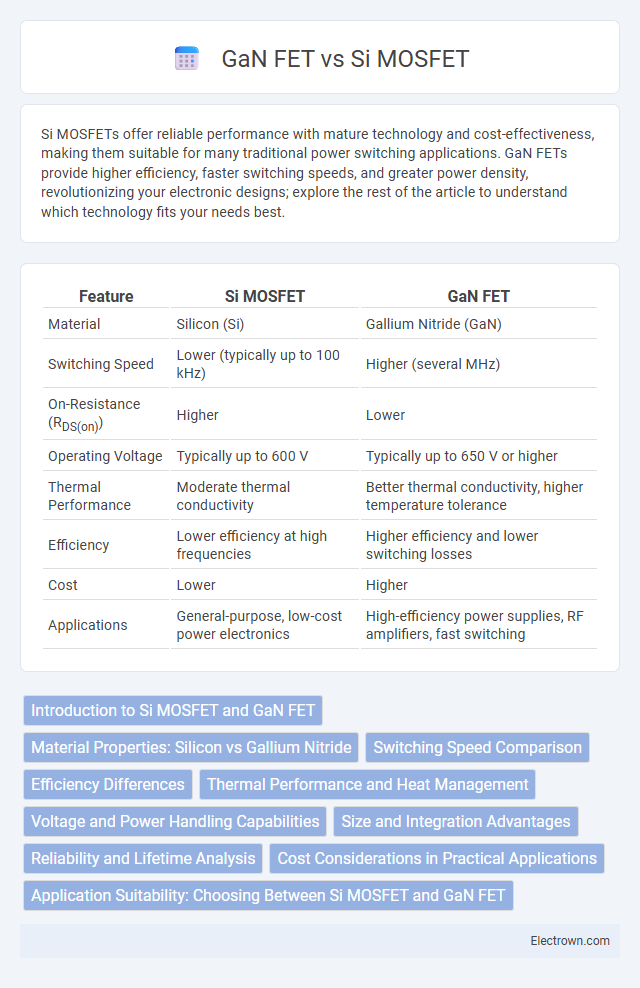Si MOSFETs offer reliable performance with mature technology and cost-effectiveness, making them suitable for many traditional power switching applications. GaN FETs provide higher efficiency, faster switching speeds, and greater power density, revolutionizing your electronic designs; explore the rest of the article to understand which technology fits your needs best.
Table of Comparison
| Feature | Si MOSFET | GaN FET |
|---|---|---|
| Material | Silicon (Si) | Gallium Nitride (GaN) |
| Switching Speed | Lower (typically up to 100 kHz) | Higher (several MHz) |
| On-Resistance (RDS(on)) | Higher | Lower |
| Operating Voltage | Typically up to 600 V | Typically up to 650 V or higher |
| Thermal Performance | Moderate thermal conductivity | Better thermal conductivity, higher temperature tolerance |
| Efficiency | Lower efficiency at high frequencies | Higher efficiency and lower switching losses |
| Cost | Lower | Higher |
| Applications | General-purpose, low-cost power electronics | High-efficiency power supplies, RF amplifiers, fast switching |
Introduction to Si MOSFET and GaN FET
Si MOSFETs, made from silicon, are widely utilized in power electronics due to their well-established fabrication processes, cost-effectiveness, and reliability in switching applications. GaN FETs, based on gallium nitride, offer superior electron mobility, higher breakdown voltage, and faster switching speeds, making them ideal for high-frequency, high-efficiency power conversion systems. The distinct material properties of GaN enable enhanced performance in compact, high-power-density devices compared to traditional Si MOSFETs.
Material Properties: Silicon vs Gallium Nitride
Gallium Nitride (GaN) offers higher electron mobility and wider bandgap energy compared to Silicon (Si), enabling GaN FETs to operate at higher voltages, frequencies, and temperatures with improved efficiency. Silicon MOSFETs benefit from mature fabrication technology and lower costs but exhibit higher on-resistance and slower switching speeds than GaN devices. Your choice between Si and GaN depends on application requirements for power density, switching performance, and thermal management.
Switching Speed Comparison
GaN FETs exhibit significantly faster switching speeds compared to traditional Si MOSFETs due to their wider bandgap and lower parasitic capacitances, enabling efficient operation at higher frequencies. These characteristics reduce switching losses and improve overall power conversion efficiency, especially in high-frequency applications like RF amplifiers and power inverters. Your choice of GaN technology can enhance performance in scenarios demanding rapid switching and minimal signal distortion.
Efficiency Differences
GaN FETs exhibit significantly higher efficiency than Si MOSFETs due to lower on-resistance (R_DS(on)) and reduced gate charge, which minimizes switching losses and conduction losses in power applications. The wide bandgap of GaN enables faster switching speeds and higher breakdown voltages, resulting in improved power density and thermal performance. Consequently, GaN FETs are preferred for high-efficiency, high-frequency power conversion and RF amplification tasks where Si MOSFETs often fall short.
Thermal Performance and Heat Management
GaN FETs exhibit superior thermal performance compared to Si MOSFETs due to their higher electron mobility and wider bandgap, enabling lower on-resistance and reduced power dissipation. The enhanced heat tolerance of GaN devices allows operation at higher junction temperatures, improving efficiency in high-frequency applications. Advanced heat management techniques, such as improved substrate materials and optimized packaging, further leverage GaN's thermal advantages over traditional silicon-based MOSFETs.
Voltage and Power Handling Capabilities
GaN FETs offer superior voltage and power handling capabilities compared to traditional Si MOSFETs, with breakdown voltages typically exceeding 600V and power densities reaching above 10 kW/cm2. Silicon MOSFETs generally operate efficiently below 250V and exhibit lower maximum power densities around 2-3 kW/cm2, which limits their use in high-voltage, high-power applications. The wide bandgap of GaN enables higher electron mobility and thermal conductivity, allowing devices to handle increased voltages and dissipate heat more effectively under high power conditions.
Size and Integration Advantages
GaN FETs offer significant size reduction compared to Si MOSFETs due to their higher electron mobility and superior switching speeds, enabling more compact and efficient designs. Their smaller die area and reduced parasitic capacitance allow for higher power density and better thermal management in integrated circuits. You can achieve greater miniaturization and enhanced integration capabilities with GaN FETs, making them ideal for next-generation power electronics.
Reliability and Lifetime Analysis
GaN FETs exhibit superior reliability under high-temperature and high-frequency conditions compared to Si MOSFETs due to their wide bandgap and robust material properties. Si MOSFETs, while well-established, typically experience shorter lifetimes attributed to higher leakage currents and thermal degradation in demanding environments. Lifetime analysis indicates GaN devices sustain longer operational periods with less performance drift, making them advantageous for high-reliability power electronics.
Cost Considerations in Practical Applications
Si MOSFETs generally offer lower upfront costs and mature manufacturing processes, making them cost-effective for widespread applications such as consumer electronics and automotive systems. GaN FETs, while initially more expensive due to complex fabrication and material costs, provide superior efficiency and higher switching speeds that can reduce overall system costs in high-performance environments like RF amplifiers and data centers. Evaluating total cost of ownership involves balancing Si MOSFET's affordability against GaN FET's potential for energy savings and miniaturization in specific high-frequency or high-power applications.
Application Suitability: Choosing Between Si MOSFET and GaN FET
Si MOSFETs offer robust performance and cost-efficiency, making them ideal for low to medium power applications such as consumer electronics and automotive systems. GaN FETs exhibit superior switching speed, higher efficiency, and thermal performance, which suit high-frequency applications like 5G infrastructure, RF amplifiers, and power converters. Selecting between Si MOSFET and GaN FET depends largely on application requirements regarding switching speed, efficiency, thermal management, and cost constraints.
Si MOSFET vs GaN FET Infographic

 electrown.com
electrown.com